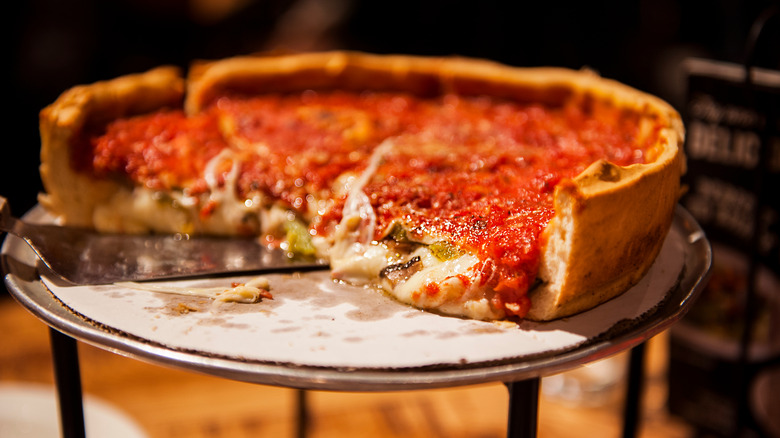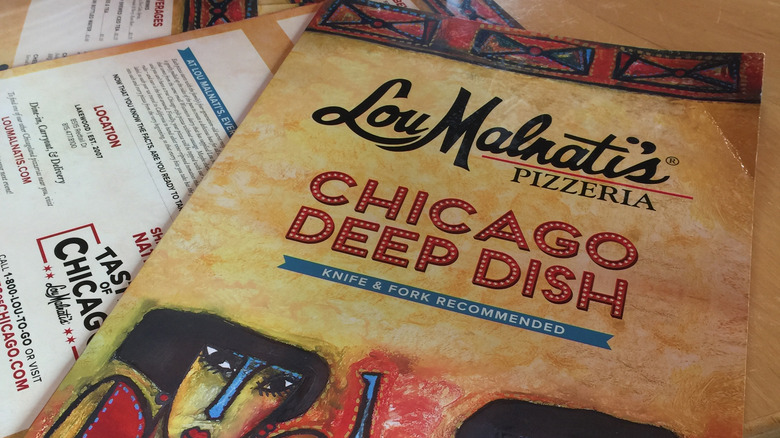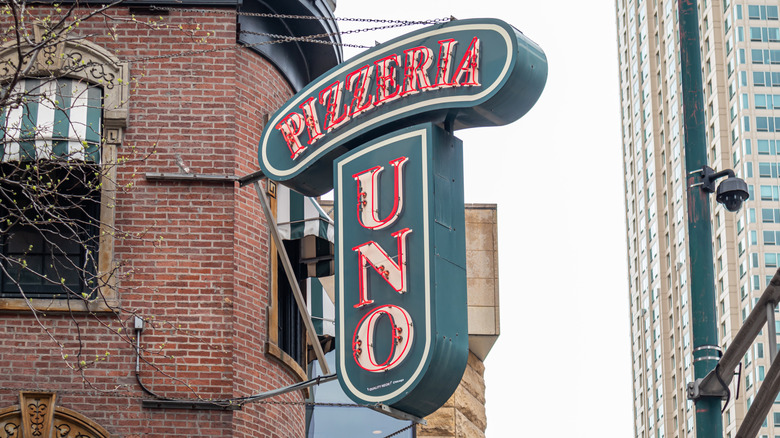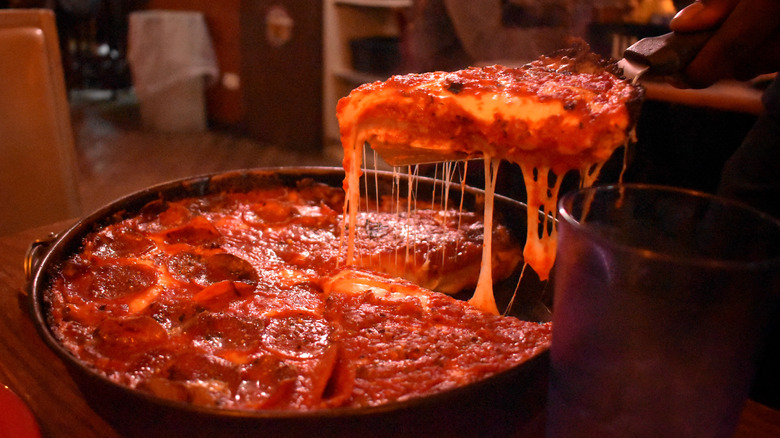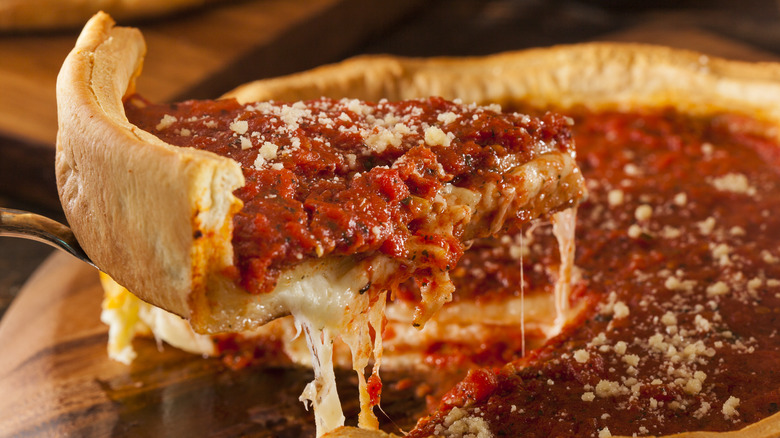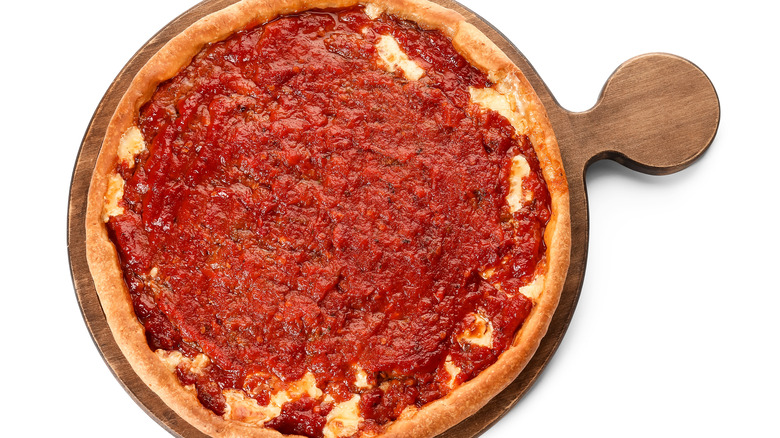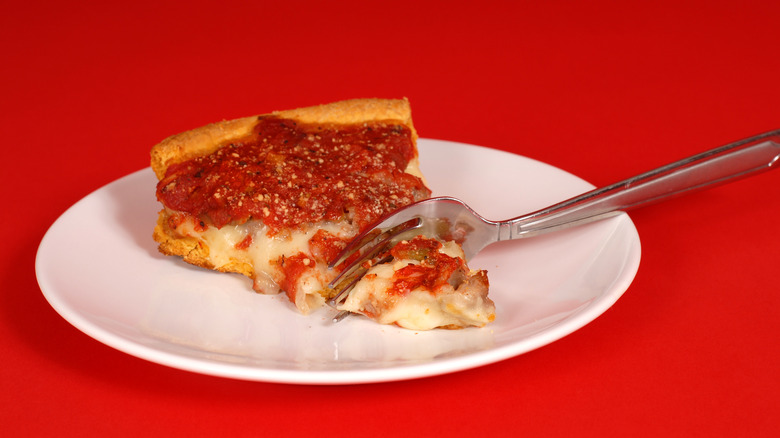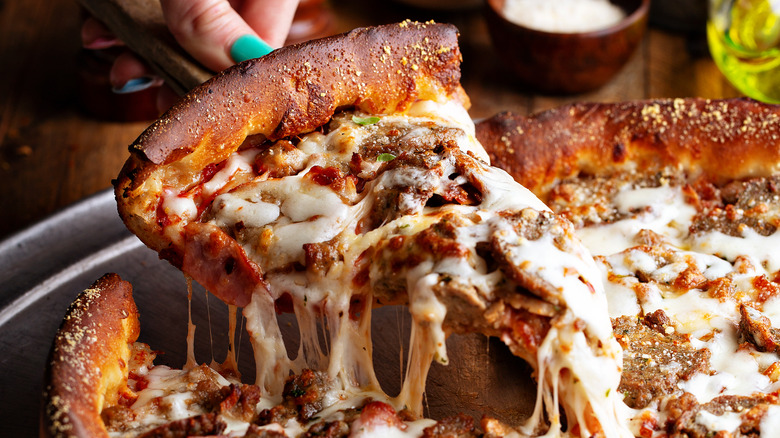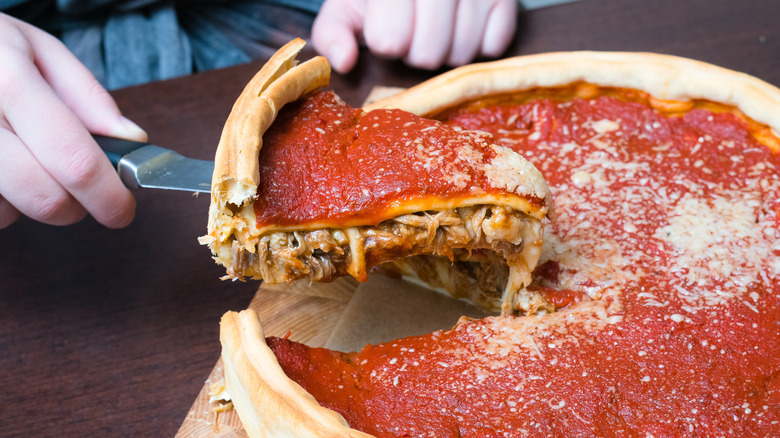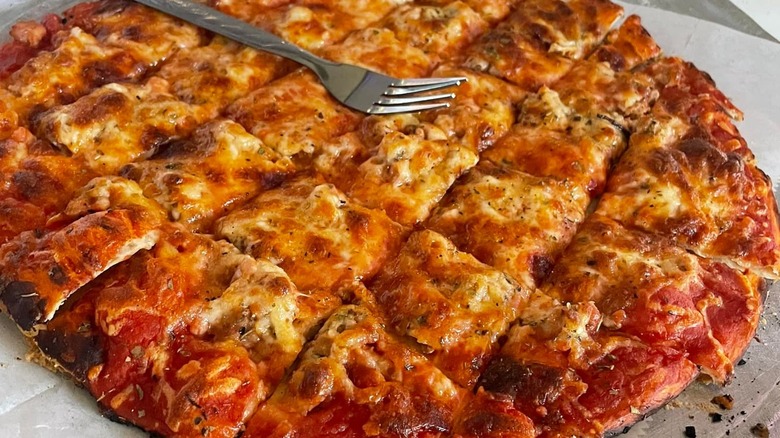The Untold Truth Of Chicago Deep-Dish Pizza
Whether you eat pizza in New York or Naples, Detroit or New Haven, or any number of regional pizza styles, it always seems to follow at least a similar formula, if not precisely the same recipe. Order a pizza, and you'll be presented with a thin round of dough that has been dressed with tomato sauce, cheese, and maybe a few other toppings. The result is baked until the dough is cooked through and the cheese melts until it's become bubbly and a bit browned. A slice might be eaten with a fork and knife in Italy, per NPR, or folded in half and scarfed on the go in New York. Either way, line up these pies and they will surely all look, if not like twins, at least like siblings.
But Chicago is a whole other story. The deep-dish pizza for which the Windy City is now famously known is arguably more of a casserole than a pizza, evoking better than any other the "pie" part of "pizza pie." But where did this obsession with deep-dish come from? Who was the first to bake such a culinary creation, not on a sheet pan or directly on the oven floor as other styles demand, but in a cast iron cake pan? And why are some folks so vocal in their hatred for it?
The responses to these questions and more are to come, as we delve into everything you didn't know you needed to know about Chicago deep-dish pizza.
Chicago deep-dish pizza supposedly began at pizzeria Uno
Ask most people where Chicago deep-dish pizza got its start, and they'll point you to Chicago's North Side. Specifically, they may direct you to Pizzeria Uno, which got its start back in 1943. According to the most common origin story, the BBC reports, Uno's owners Ike Sewell and Ric Riccardo invented the hefty pie in the early 1940s. According to The Culture Trip, Sewell and Riccardo baked their first pizzas in a deep pan, reordering the layers of the ingredients to keep the cheese, traditionally placed on top, from burning to an unpalatable crisp.
These days Pizzeria Uno has been franchised in over 200 locations across the country and even across the globe. These locations sport the moniker Uno Pizzeria & Grill, per The Culture Trip, whereas the original spot is still dubbed Pizzeria Uno.
However, it turns out that the invention story of deep-dish pizza isn't nearly as cut-and-dried as Uno's would have you believe.
Other popular pizza restaurants may have invented deep-dish
Ike Sewell and Ric Riccardo may have claimed to be the originators of Chicago deep-dish, but others assert that while Uno's may well have been the place of origin, the owners had little or even nothing to do with the recipe's creation.
Adolpho "Rudy" Malnati, Sr., whose son later founded Lou Malnati's, now a Chicago deep-dish restaurant staple, was an employee of Uno's. According to some accounts, he may in fact have been the originator of the recipe. Per the BBC, these claims seem to hold water, with little evidence of Sewell or Riccardo spending much time in the Uno's kitchen. According to this version of the tale, Malnati came up with the idea and recipe for deep-dish. He later managed Uno's with his son until his death. At that point, Lou broke off to found his titular Lou Malnati's Pizzeria in 1971, taking the recipe with him.
The tale grows even more complicated when you add yet another pizzeria to the mix. In a twist that rings of soap opera drama, Rudy Malnati had another son — Lou's half-brother, Rudy Jr. — who claims that Rudy Sr. gave him the real recipe. Rudy then used it to open Pizano's in 1991, according to the BBC.
"It's an enigma wrapped in a pie crust," author and food critic Jeff Ruby told the Chicago Tribune about the dish's hazy origins.
Deep-dish pizza was reportedly born of necessity during WWII
Whoever actually came up with the unique deep-dish pizza as it's served in restaurants today was standing on the shoulders of giants. Ultimately, deep-dish pizza would not exist if not for the Neapolitan immigrants who arrived in Chicago through the late 19th and early 20th century, according to the BBC.
While these Italian immigrants certainly made a host of dishes from their homeland from the beginning of their time in the region, their original take on pizza was a thin, crispy variety. It wasn't until World War II that the stars aligned to make deep-dish pizza possible. Indeed, asserts The Kitchn, it was World War II rationing that provided the real push for this dish. Seeing as the ingredients for the dough itself were not rationed, it was an easy meal to pull together at a low cost. Since the filling could be made out of leftovers, further stretching limited ingredients and dollars, it was the ideal food for the families of hungry, calorie-burning workers to cook up with whatever they had on hand.
Uno's is a right of passage for Chicago's pizza makers
Regardless of who actually cooked up the original Chicago deep-dish recipe, one thing is for sure: working at Uno's is a right of passage when it comes to making traditional deep-dish pizza in the Windy City. The BBC reports that, in addition to the Malnati brothers, the original pizzaiolos at Gino's East — said to be Chicago's second-oldest deep-dish spot, founded back in 1966 — had first passed through the kitchens at Pizzeria Uno. These included Alice May Redmond who, with her sister Ruth Hadley, was put to the task of crafting deep-dish at Gino's East. They helped to turn it into one of the most successful deep-dish spots in the city. According to The Culture Trip, local favorites like Delisi's Pizza and Louisa's Pizza were both also founded by former Uno's team members, as well as Gino's East.
Whether Sewell and Riccardo actually invented deep-dish or not, it's clear that their restaurant had a hand in bringing to the fore some of the most renowned pizza creators in the city.
Chicago deep-dish pizza is made in a very unique way
Look at a deep-dish pizza, and you'll find that its construction stands out compared to the other, less hefty pizzas you might be used to. It all starts with the baking vessel that gives the pizza its name: a deep pan that the BBC asserts would be perhaps a more likely home for a cake than a pizza. According to Vice, these cast iron cooking vessels are traditionally never washed but instead wiped down between uses. Over time, this adds seasoning to the pan, making it better and better at creating a complex and delicious pizza with each use.
To make the pizza, the BBC explains, the cooking vessel is coated first in a layer of olive oil before bakers add a semolina dough. This dough lines not just the sides of the pan, but also the edges, much like a traditional sweet pie. Thusly prepared, the pizza pan is ready for the layering of the ingredients, a process that proves to be yet another way in which Chicago changes things up from the norm.
The order of Chicago deep-dish pizza layers may surprise you
Whereas most pizzas are made by topping the dough base with a layer of sauce and then a layer of cheese, followed by any additional toppings, the walls of dense crust used to make a Chicago deep-dish pizza are filled in a different and fairly distinctive fashion.
First, as Vice reports, cheese is placed on the dense dough as a protective layer. This cheesy bed is topped with meat, which is typically either pepperoni or sausage, the latter of which is added raw so that the fat seeps into the bottom crust. The layers are then alternated until you've filled the pizza about three-quarters of the way, at which point the pizza maker adds a layer of sauce at the very top.
Per the BBC, a truly good Chicago deep-dish pizza will boast a crunchy crust that has nearly been fried in the olive oil that coats the pan. Meanwhile, the top layer of tomato sauce forms a protective barrier, keeping the cheese from burning during the pizza's rather long 40-minute sojourn in the oven, according to Vice.
Traditional Chicago deep-dish uses a special sauce
Lots of people talk about how different the structure of Chicago deep-dish pizza is compared to other regional styles, but not enough is said about its unique sauce. According to Simply Recipes, one of the signs of a good Chicago deep-dish pizza is a spicy sauce that is both chunky and relatively sweet, at least compared to other pizza sauces. Some restaurants also give the sauce a good punch of garlic, reports the BBC. Ultimately, it needs to be thicker than most tomato sauces to keep it from making the final dish a sloppy mess, as well as protect all those layers from the heat of the pizza oven.
According to The Pizza Heaven, the sauce also has one added oddity compared to other pizza styles: It's often added to the pizza uncooked. That's ostensibly because, given the long bake time of the pizza, it will cook down in the oven instead of on the stovetop. Going with what is essentially a raw marinara sauce certainly cuts down on the preparation time for this pizza considerably.
You're going to need a fork
Given the unique construction of Chicago deep-dish pizza, it's no surprise that a slice can't be folded in half like its much thinner New York cousin. For the BBC, the result is more comparable to cake than a pizza. Meanwhile, Vice asserts that, if the pizza was cooked correctly, it should come out of the pan easily and in one piece with a gorgeous, layered cross-section, not to mention a perfect mozzarella cheese pull. The Culture Trip notes that you'll need some hefty kitchen tools to serve up this fork-and-knife-driven meal (something the menu at Lou Malnati's proudly puts forth as a house recommendation).
Of course, Chicago deep-dish pizza isn't the only kind best enjoyed with a fork and knife. In Italy, as Eataly asserts, most pizza fans enjoy their pizza with a fork and knife, even if only at the beginning of the fresh from the oven hot meal. The center-most bites are difficult to enjoy out of hand, though once you've eaten from the inside out, it's totally fine to pick up the outer crust and finish it with your fingers.
Chicago deep-dish pizza is not healthy
Deep-dish is certainly delicious, but it's also undeniably a gut bomb. One 149-gram slice of deep-dish pizza from Gino's East, according to Eat This Much, contains a whopping 420 calories and 22 grams of fat, of which 8 grams is saturated. With 609.4 mg of sodium, it contains just less than a quarter of all the salt that the CDC's Dietary Guidelines for Americans recommends people eat in a whole day. Moreover, Real Deep Dish attests that this calculation only works if you're cutting your 12-inch pizza into eight slices. If you go for a heftier portion of six slices per pie, you're looking at upwards of 600 calories per serving.
Now, it's not as though anyone has ever thought that pizza was health food. Still, compare those numbers with New York pizza, for example, and you're more than doubling — if not tripling — the calories per slice, according to HealthiNation.
The huge caloric load of deep-dish has as much to do with the pizza itself as it does with the typical toppings. While New York slices are often eaten plain, the omnipresence of meats like sausage and pepperoni in Chicago-style pizza definitely make it a heavier, heartier meal compared to many other styles.
Celebrities have opinions about Chicago deep-dish pizza
Haters, as they say, gon' hate, and there's perhaps no foodstuff that garners such vociferous diatribes as Chicago deep-dish pizza. Chefs like Anthony Bourdain and Mario Batali have proven to be vehemently anti-deep-dish, according to The Kitchn, with Bourdain dubbing the pizza an "abomination," per Eater. Batali even asserted that native Italians would "kill themselves" if they saw what Chicago served under the moniker of pizza, according to Eater.
It's not just professional foodies who have some serious anti-deep-dish views. Late-night host and New Yorker Jon Stewart went so far as to deliver an epic rant about deep-dish pizza, dubbing the dish "not pizza" but, rather shockingly, a "casserole."
"It's a cornbread biscuit which you've melted cheese on and then — in defiance of God and man and all things holy — you poured uncooked marinara sauce atop the cheese. Atop!" he said on his popular talk show, "The Daily Show." His anger was certainly made at least a bit hyperbolic for humor, but if comments beneath the video are to be believed, he's not the only one with such a negative opinion of the dish.
Deep dish is not the same as stuffed pizza
What many who malign deep-dish pizza seem to miss a significant fact: sometimes they're not criticizing the right dish. Chicago is home to not just one, but two thicker-than-normal pizzas: deep-dish and stuffed. While the former is the original of the two styles, the latter is far more Instagrammable, according to pizza expert Steve Dolinsky. The differences don't end there.
Stuffed pizza, according to WhereTraveler, was developed in the '60s by either Nancy's or Giordano's (the origin story is a bit murky). Even thicker than a traditional deep dish, stuffed pizza takes a page out of the book of a traditional savory pie served at Easter in Italy. It sports an additional cracker-thin crust topped by even more tomato sauce. According to The Spruce Eats, it's also usually made with an even flakier crust than deep-dish. All told, it's a take on pizza that takes things to an even more intense level.
Yet, that doesn't mean it's won everyone over. For Dolinsky, stuffed pizza looks a lot better than it tastes. As gorgeous as all that cheese pull is, he notes, it's far heavier than it really needs to be and the experience of eating a whole slice of the heavy stuff can be compared to outright torture.
Deep-dish is not necessarily the preferred pizza of Chicago
Chicago has not one but two different kinds of deep-dish pizza (three, if you count pan pizza, which pizza expert Steve Dolinsky says is similar to deep-dish with the added distinction of being par-baked). Yet, most Chicagoans grabbing a pizza on any given night aren't going for the thick slabs of deep-dish but rather a cracker-thin pie popularly known as tavern-style. According to Bon Appétit, tavern-style pizza is Chicago's true hometown pizza, boasting a crispy crust topped edge-to-edge with tomato sauce, cheese, and other toppings. Perhaps most distinctively, the round pizzas are "party cut" into squares.
This pizza is said to have been invented in 1946 at Vito & Nick's by World War II veteran Nick Barraco. The restaurant was founded by his parents, Sicilian immigrants Vito and Mary Barraco, in the '20s. This pizza is often topped with mozzarella and pepperoni and, in yet another break with pizza tradition, is usually cooked in a stainless-steel deck oven rather than the wood-burning ovens preferred by New York pizza joints.
Some modern spots add new twists to the classic recipe
While Chicago deep-dish pizza has a long and storied past, that isn't stopping some modern chefs from taking a few contemporary liberties with the classic. The Culture Trip notes that, at Chicago Pizza and Oven Grinder Co., deep-dish pizza has been reimagined as a pizza pot pie of sorts, baked in an individual ramekin. The pizza is inverted tableside for an impressive presentation.
Meanwhile, according to the Chicago Tribune, the iteration of the classic at Beatrix Market is yet another individually-sized marvel, made with a very thin crust that magically manages to be less greasy but even more delicious than the thicker variety served up at many classic joints.
The Gluttonous Geek even created a play on the classic inspired by urban fantasy series "The Dresden Files," which you can make at home and enjoy whether you're in the Windy City or not!
